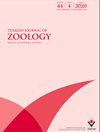三种蚂蚁(膜翅目:蚁科)沿小径移动速度的比较
IF 1.7
4区 生物学
Q2 ZOOLOGY
引用次数: 0
摘要
本研究的目的是比较3种蚂蚁(Formica rufa, F. polyctena和Lasius fuliginosus)在不同类型基质上的移动速度。该研究于2022年6月至8月在乌克兰基辅的Holosiyivo森林内进行。对于L. fuliginosus,研究于2022年8月和9月进行。实验中,每个菌落在6月份选取3个菌落,只有3个菌落通过底物(共9个菌落)。其中一条小径保持不变(地面),第二条小径铺上光滑的原木,第三条小径铺上树皮。通过检查每个工蚁(总共4678只)的个人轨迹,测量了每种基质类型蚂蚁的移动速度(s/10厘米)。当高速公路的轨迹与小路不一致,而是走最短的路径时,蚂蚁不会穿过高速公路,或者只在某些路段穿过。2022年8月,在记录了轨迹后,所有高速公路都重新铺设了公路。在一周或一周半内,蚂蚁完全转向高速公路。在所有基质类型中,体型较大的蚂蚁(f.r rufa, f.r polyctena)的移动速度是体型较小的蚂蚁(l.f uliginosus)的1.6 - 1.9倍。其中一个物种的移动速度在不同的基质类型之间有所不同。芦花菌在地面上的移动速度比在原木上慢62%,多叶草菌慢50%,富利菌慢61%。在3种基质类型中,蚂蚁最喜欢公路上的原木。在所有情况下,蚂蚁在原木上的移动速度都与最大速度相关,比在地面上快38%-50%。虽然F. rufa工人每单位时间在树皮和地面上运输的食物量相似,但它们在原木上运输的食物量是在地面上运输的1.75倍,是在树皮上运输的1.15倍。在树干上的食物运输量最高(1.13倍),略低于树皮上的食物运输量;在地面上的食物运输量最低(4.15倍于原木,3.64倍于树皮)。高速公路的使用加速了蚁群的生长,并通过改善步道基础设施人为地创造了一个巢穴。未来的研究应该比较红木蚁在有和没有人工步道网络的情况下巢丘的生长速度本文章由计算机程序翻译,如有差异,请以英文原文为准。
Comparison of the movement speed of three ant (Hymenoptera: Formicidae) species along trails
The aim of this study was to compare the speed of movement of 3 species of ants (Formica rufa, F. polyctena, and Lasius fuliginosus) along trails with different types of substrates. The study took place from June to August 2022 within the Holosiyivo Forest, located in Kyiv, Ukraine. For L. fuliginosus, the study was conducted in August and September 2022. For the experiment, 3 colonies of each species were selected in June, with only 3 trails passing on substrate (a total of 9 trails). One of the trails was left unchanged (ground surface), smooth logs were laid on the second and bark on the third. The movement speeds of the ants were measured for each substrate type (s/10 cm) by examining the individual trajectories of each worker (4678 in total). When the highway trajectory did not coincide with the trail and followed the shortest path instead, the ants did not cross the highway or crossed it only in some sections. In August 2022, all of the highways were relaid after the trail trajectories were recorded. Within a week or a week and a half, the ants switched completely to the highways. Larger-sized ant species (F. rufa, F. polyctena) moved 1.6 to 1.9 times faster than the smaller ones (L. fuliginosus) across all of the substrate types. For one of the species, the movement speeds differed between the different substrate types. F. rufa moved 62% slower on the ground surface than on logs, F. polyctena 50% slower, and L. fuliginosus 61% slower. Of the 3 substrate types, the ants preferred logs on highways the most. Ant movement on the logs was in all cases associated with the maximum speed, at 38%-50% faster than on the ground surface. While the F. rufa workers transported a similar amount of food per unit of time on both the bark and the ground surface, they transported 1.75 times more food on the logs than on the ground surface and 1.15 times more than on the bark. For F. polyctena, the highest amount of food transported on the logs was slightly less than that on the bark (1.13 times) and the lowest on the ground surface (4.15 times less than on the logs and 3.64 times less than on the bark). The usage of highways accelerates colony growth and artificially creates a nest site by improving trail infrastructure. Future studies should compare the growth rate of nest mounds over time in colonies of red wood ants with and without artificial trail networks
求助全文
通过发布文献求助,成功后即可免费获取论文全文。
去求助
来源期刊

Turkish Journal of Zoology
ZOOLOGY-
CiteScore
2.30
自引率
10.00%
发文量
24
审稿时长
6-12 weeks
期刊介绍:
The Turkish Journal of Zoology is published electronically 6 times a year by the Scientific and Technological Research Council of Turkey (TÜBİTAK).
-Accepts English-language manuscripts in various fields of zoology including systematics, developmental biology, behaviour biology, animal models, molecular biology and molecular phylogeny, genomics, physiology (cell communication and signaling systems), biochemistry and immunohistochemistry, applied parasitology and pathology, nanobiotechnology, ecology, evolution, and paleontology of animal taxa.
-Contribution is open to researchers of all nationalities.
-Short communications are also welcome, such as reports of a preliminary nature or those including new records from specific localities or regions, and the editor reserves the right to decide that a paper be treated as a short communication.
-The papers that deal with purely checklists, new host and non-regional new locality records will not be consider for publication.
-Letters to the editor reflect the opinions of other researchers on the articles published in the journal. The editor may also invite review articles concerning recent developments in particular areas of interest.
 求助内容:
求助内容: 应助结果提醒方式:
应助结果提醒方式:


